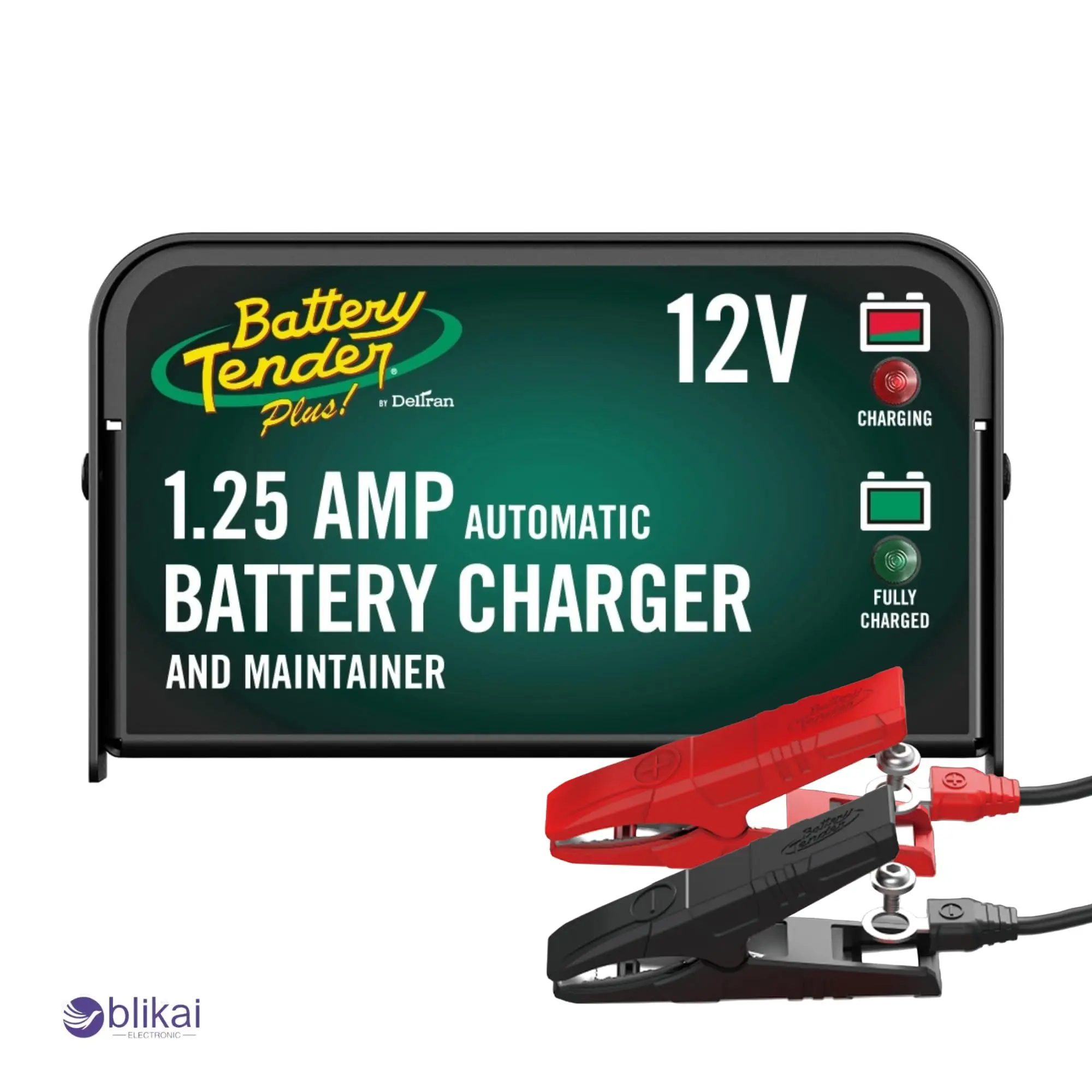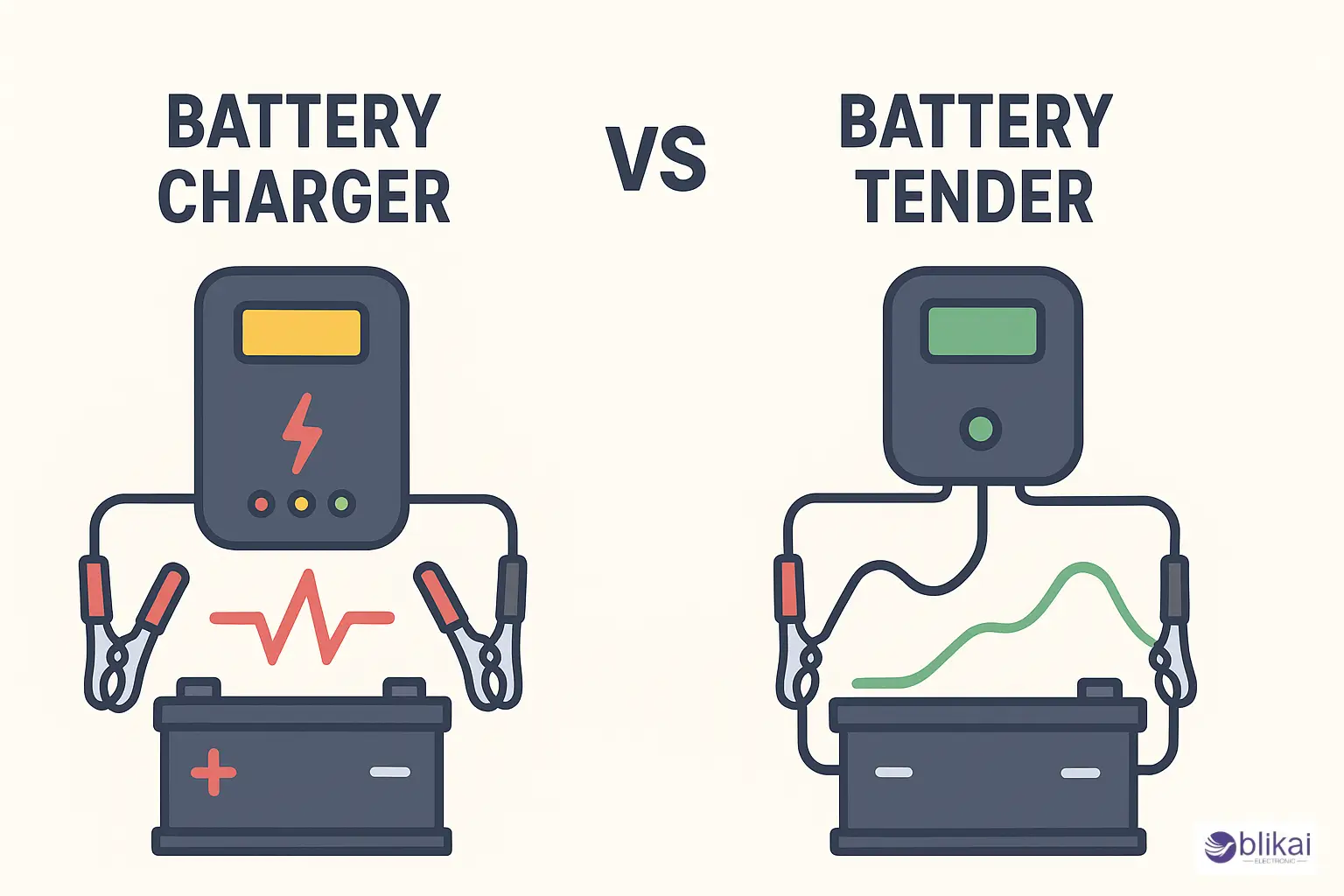What Is a Battery Tender? Complete Beginner’s Guide
What Is a Battery Tender?
A battery tender refers to a special apparatus that holds the charge of a battery for a long time without charging it. Battery tenders offer a slow, controlled charge, also known as trickle charging, unlike conventional chargers, which restore charge to a low-voltage battery in a short period of time. This maintains the battery at a good level of voltage and prevents the battery from being damaged due to undercharging or overcharging.
Definition of a Battery Tender
A battery tender is a maintenance charger, which is used to check the condition of a battery and only supply power when required. It is built to give a steady amount of voltage to a battery and is used to counter the self-discharge of batteries over time. The majority of battery tenders created nowadays also have smart technology, which is used to automatically activate to charge the battery or to switch to maintenance mode based on the charge level of the battery. There is a wide range of batteries, such as lead-acid, AGM battery and lithium-ion, with which battery tenders can be used, and they are therefore very useful in ensuring that the batteries remain in their optimal condition and are not affected by some undesirable issues such as sulfation or deep discharge.
Typical Applications
The battery tenders are usually applied in those cases when vehicles or equipment are not in daily usage. Boats, motorcycles, RVs, and classic cars tend to be kept idle (weeks or months) and, in the process, their batteries are able to discharge naturally. This can be prevented through a battery tender that will keep the charge safe and constant so that the vehicle is ready when required. They can also be useful in seasonal equipment like snowmobiles or lawn mowers, and also vehicles that are used in recreational work like ATVs and jet skis.

How a Battery Tender Works
A battery tender works by supplying a controlled amount of electricity to a battery to keep it at an optimal charge level. Once the voltage on the battery falls below a specific level, the tender will turn on and start charging the battery and turn on to maintenance mode once the battery is full. This is because this constant checking will ensure that the battery is not overcharged and lose its life; the life of the battery is also prolonged.
The Concept of “Trickle Charging” and Maintaining Battery Health
The gist of battery tenders is trickle charging. By doing so, a tiny constant stream of current is delivered to the battery over a long duration, which balances the natural self-discharge without putting a strain on the internal chemistry of the battery. Trickle charging ensures that a battery does not experience problems like sulfation in lead-acid batteries, which takes place due to prolonged maintenance of a partially discharged battery. In lithium-ion batteries, it helps avoid deep discharge, which is capable of permanently depleting capacity. The trickle charging basically maintains the battery in a ready state, and as such, it can be relied upon to be ready whenever required.
Safety Features Like Overcharge Protection
New battery tenders have safety features that are able to secure the battery as well as the user. Another feature, which is the most essential, is overcharge protection that prevents or halts the charging current in the moment the battery is completely charged. Many tenders also offer reverse polarity protection to prevent damage in case of plugging the charger in reverse. Temperature monitoring is another common safety measure, varying the charge rate when the battery is either too hot or too cold. These characteristics limit the chances of battery failure, fire or damage and thus, battery tenders can be used over longer durations safely than traditional chargers, particularly when a battery is left unattended for weeks or months.
Differences Between 6V and 12V Models
Battery tenders are also divided into voltages, usually 6V or 12V, which will be compatible with the battery it is sustaining. Smaller batteries, like those in a motorcycle, scooter or older classic car, have a 6V tender, whereas modern cars, trucks and other larger recreational vehicles have a 12V tender. The selection of the proper voltage is also important, as improper voltage will cause harm to the battery or make the tender useless. There is also the advanced tenders, which can switch between 6V and 12V, which means that the user can switch between the types of vehicles they may possess.
What Is the Difference Between a Battery Tender and a Battery Charger?
Despite the fact that both a battery tender and a typical battery charger supply power to a battery, they have very dissimilar functions and operations. A normal battery charger is one that is designed to recharge a battery that is used up very fast to full capacity, and in most cases, it offers a high amperage of current. Although it is good to use immediately, it may overstress the battery when used constantly or when left unattended. On the other hand, a battery tender is designed to be long-term maintained, which gives a low and constant current that keeps the battery at its optimum voltage without overcharging. This slow and continuous process of charging keeps the battery healthy and the duration lifetime, which is highly important to those vehicles or equipment that are not used on a daily basis.

Key Operational Differences
One of the major differences is monitoring and automation. Battery tenders have smart technology, and that is why they can monitor the charge level of the battery and automatically adjust the current strength. They switch to charging and maintenance states, and it guarantees that they are not overcharged and have fewer risks of being damaged. Ordinary chargers are, however, not as intelligent as this and do not have a system to stop overcharging, and therefore, one must be watched over manually. Also, battery tenders typically have several safety features, including reverse polarity and temperature detection, built into them, allowing them to be used unattended, compared to normal chargers, which are more appropriate for short-term, attended charging.
Best Use Cases for Each
When a battery is drained and requires a little backup to get a vehicle or piece of equipment moving, it is best to use a battery charger. They particularly help in emergencies or vehicles that are used on a daily basis and are recharged daily. Battery tenders have, however, proven to be effective in long-term maintenance, like on a motorcycle, classic car, boat, or seasonal equipment that might go idle for weeks or months. In this case, a battery tender will maintain the battery loaded and active and reduce the risks of sulfation and deep discharge, and lastly increase the life of the battery when compared to a regular charger.
How to Use a Battery Tender
This will involve turning off the tender and ensuring that the vehicle or battery is not running. Attach the positive (red) clamp to the positive terminal of the battery, the negative (black) contemporary to the negative terminal. Plug the tender after fitting it safely in a power outlet and powering it. In the event of a disconnection, be sure to first de-energize and unplug the tender. The negative clamp should then be removed, and the positive clamp later on. This order will minimize the risk of sparking, short circuiting or inadvertent harm to the battery and tender.
Tips for Monitoring Battery Status
Smart tenders will include LED indicators or digital displays indicating charge status, voltage and possible faults. To deal with simple tenders without indicators of higher complexity, it is advisable to occasionally test the voltage of the battery on a multimeter to keep it within the suggested range. Physical signs that can be used to identify problems at an early stage are observing corrosion on terminals, swelling, or leaks. Frequent checks will ensure that you identify the issues early enough to fix them before they become a nightmare and take care of the battery in the best condition, as well as prevent surprises when the battery is required the most.
Conclusion
A battery tender is a tool that is necessary in ensuring the health and longevity of a large variety of batteries, especially in the case of vehicles and equipment that are not utilized on a daily basis. Battery tenders avoid overcharging, undercharging and other typical battery problems like sulfation or deep discharge by applying a controlled low current charge and using intelligent monitoring technology. As a professional and sensible idea, giving a high-quality battery tender is the best decision to make by any person who wishes to keep their batteries in the best possible state.
FAQ
Can a battery tender replace a regular battery charger?
No. Battery tenders are for long-term maintenance with low, controlled current, while regular chargers quickly restore depleted batteries. Each serves a different purpose depending on usage needs.
Which batteries are compatible with battery tenders?
Battery tenders work with lead-acid, AGM, and lithium-ion batteries. Choosing the correct voltage and type ensures safe, effective maintenance and prolongs overall battery life.
Some images are sourced online. Please contact us for removal if any copyright concerns arise.
L1131 Battery Equivalent: Features & Applications
Battery Desulfator: How It Works & Why It Matters
A27 Battery: Lifespan, Applications & Alternatives
CR2477 Battery: Features, Applications & Lifespan
1/3N Battery: Applications, Lifespan, & Key Features Explained
NMC Battery vs. LFP Battery: A Detailed Comparison
EFB Battery vs. AGM Battery: Comparing the Differences
Dry Cell Battery vs Wet Cell Battery: Differences
NiCd Battery vs NiMH Battery: Differences
Boat Battery: Types, Chemistry & How to Choose










